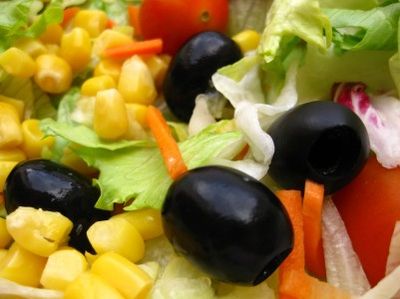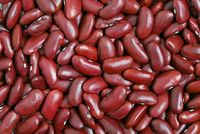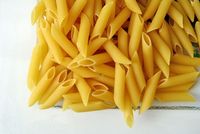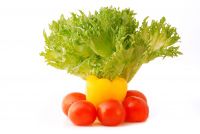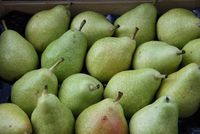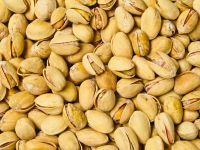Fiber
Fiber is an essential part of a healthy diet, and is frequently misunderstood. Fiber does far more than prevent constipation, helping with weight loss and overall health. Fiber is broadly defined as edible food that cannot be digested in the small intestine, and while some fiber is completely indigestible, other types can be partly digested further down the digestive tract.
Contents
1 Weight Loss and Fiber
One of the key benefits of fiber is to help with weight loss and weight control. Fiber can help with weight loss in many ways:
- Fiber can slow the emptying of the stomach, and delay the absorption of nutrients in the small intestine. This produces a feeling of fullness for longer[1] and fiber (30g/day) reduces hunger from low calorie diets[2].
- Higher fiber intake is linked to long term weight control[3][4][5][6].
- Fiber displaces the more energy dense components of food[7] and can reduce the absorption of fat and protein[8].
- Calories from fiber that is fermented varies between 1.5 and 2.5 Calories/gram[9][8].
- Fiber reduces the Glycemic Index of foods, which may be why fiber reduces subsequent hunger[7][10][11].
- Fiber reduces the energy that is absorbed from other (non-fiber) food[12].
2 Other Health Benefits
There are a number of other health benefits from increased fiber intake.
- Some fiber is fermented in the colon by bacteria. This fermentation produces carbon dioxide, methane, hydrogen, and short-chain fatty acids. These short chain fatty acids are the preferred fuel for the cells in the colon[13] and if they are lacking they may cause Ulcerative colitis[14][15] and the colon cells to self-digest[16].
- Some, but not all, types of fiber will reduce constipation. For instance, Guar Gum is highly fermentable and does not change stool consistency[17].
- Some types of fiber can normalize cholesterol levels[18].
- Cereal fiber provides substantial protection from Coronary Heart Disease[19][20][21]. (There is little evidence for other types of fiber[18].)
- Fiber may provide protection against colorectal cancer, though the evidence is not conclusive[22][23]. In addition, fiber may protect against breast cancer[24].
3 Increasing Your Fiber Intake
Rapidly increasing your fiber intake can cause digestive pain, bloating and flatulence. These problems can be minimized or avoided by increasing your fiber intake gradually. It is also important to increase your fluid intake along with your fiber intake, as fiber will absorb several times its weight in water. The health benefits of fiber may not be achievable with fiber supplements.
4 Types of Fiber
There are several ways of classifying fiber[25]:
- Fermentable and non-fermentable. While the fiber cannot be digested directly by humans, it can be fermented by bacteria that naturally live in the colon. This means that fermentable fiber helps keep your digestive bacteria healthy. These bacteria also tend to partly digest the fermentable fiber and the resulting short chain fatty acids are used by the digestive tract. Without soluble fiber, there are indications that the colon will be starved of this essential nutrition.
- Viscous and non-viscous. Some fibers form a thick, viscous gel tends to slow digestion and reduce cholesterol levels. Viscus can also fibers also help more with constipation.
- Soluble and insoluble. A soluble fiber will disperse in water, while insoluble fiber will not. While soluble and insoluble fibers tend to have different characteristics, you need to consider other aspects of a fiber to understand it's impact on your health. Most insoluble fibers are non-fermentable, but soluble fibers can either be fermentable or non-fermentable. Likewise, insoluble fiber is generally non-viscus while soluble can be either.
Depending on the combination of characteristics, there are different health benefits, as shown below[26].
| Soluble? | Viscus? | Fermentable? | Examples | Health impacts |
|---|---|---|---|---|
| No | No | No | Wheat bran |
|
| Yes | No | Yes | Inulin, wheat dextrin, oligosaccharides, resistant starches |
|
| Yes | Yes | Yes | Oats, Barley, Guar Gum, Pectin[28] (Apples, etc.) |
|
| Yes | Yes | No | Psyllium (Metamucil) |
|
Here's the same information in an alternative layout.
| Wheat bran | Inulin, wheat dextrin, oligosaccharides, resistant starches | Oats, Barley, Guar Gum | Psyllium (Metamucil) | |
|---|---|---|---|---|
| Improve digestive bacteria? | No | Yes | Yes | No |
| Slows nutrient absorption | No | No | Yes | Yes |
| Causes flatulence | No | Yes | Yes | No |
| Reduces Cholesterol | No | No | Yes | Yes |
| Reduces constipation? | Only if coarse ground | No | No | Yes |
| Normalizes stools? (Reduces both constipation and diarrhea) | No | No | No | Yes |
| Calories? | No | Yes | Yes | No |
5 Sources of Fiber
Many good sources of fiber are also generally considered healthy foods, and there is a sample list below. In addition, it's worth noting that when pasta or rice is cooked and then left to go cold, some of the carbohydrate changes to form 'resistant starch', a form of fiber. A cup of cold pasta for instance, contains about 1.9 grams of resistant starch[29].
5.1 Legumes (beans)
| Amount | Fiber (grams) | |
|---|---|---|
| Split peas, cooked | 1 cup | 16.3 |
| Lentils, cooked | 1 cup | 15.6 |
| Black beans, cooked | 1 cup | 15.0 |
| Kidney beans, canned | 1 cup | 13.6 |
| Lima beans, cooked | 1 cup | 13.2 |
| Refried beans, canned | 1 cup | 12.2 |
| Baked beans | 1 cup | 10.4 |
5.2 Grains
| Amount | Fiber (grams) | |
|---|---|---|
| Spaghetti, whole-wheat, cooked | 1 cup | 6.2 |
| Barley, pearled, cooked | 1 cup | 6.0 |
| Bran flakes | 3/4 cup | 5.3 |
| Oatmeal, quick, regular or instant, cooked | 1 cup | 4.0 |
| Popcorn, air-popped | 3 cups | 3.5 |
| Brown rice, cooked | 1 cup | 3.5 |
5.3 Vegetables
| Amount | Fiber (grams) | |
|---|---|---|
| Artichoke hearts, cooked | 1 cup | 14.4 |
| Peas, cooked | 1 cup | 8.8 |
| Broccoli, boiled | 1 cup | 5.1 |
| Sweet corn, cooked | 1 cup | 4.2 |
| Brussels sprouts, cooked | 1 cup | 4.1 |
| Potato, with skin, baked | 1 medium | 2.9 |
| Tomato paste | 1/4 cup | 2.7 |
| Carrot, raw | 1 medium | 1.7 |
5.4 Fruits
Fruits contain 0.5-1.5% Pectin by fresh weight.
| Amount | Fiber (grams) | |
|---|---|---|
| Prunes, uncooked | 1 cup, pitted | 12.4 |
| Pear, with skin | 1 medium | 5.5 |
| Apple, with skin | 1 medium | 4.4 |
| Strawberries (halves) | 1 1/4 cup | 3.8 |
| Banana | 1 medium | 3.1 |
| Orange | 1 medium | 3.1 |
5.5 Nuts
| Nuts | Amount | Fiber (grams) |
|---|---|---|
| Almonds | 1 ounce (23 kernels) | 3.5 |
| Pistachio nuts | 1 ounce (49 kernels) | 2.9 |
| Pecans | 1 ounce (19 halves) | 2.7 |
| Peanuts | 1 ounce | 2.4 |
6 Flatulence
Flatulence (gas) is a constant source of both humor and embarrassment. Unfortunately, this embarrassment causes people to avoid high fiber foods, even when they understand the benefits. The major components of intestinal gas are nitrogen, hydrogen, carbon dioxide and methane, all of which are odorless. The actual odor comes from tiny amounts of compounds such as ammonia, hydrogen sulfide, other sulfur compounds, short chain fatty acids, etc. Even though only trace amounts are produced, the human nose can detect them in concentrations as low as 1 part in 100 million[30]. The amount of gas produced is proportional to fiber intake, but the intensity of the odor is independent of fiber intake[30]. Other factors, such as beer intake, increases flatulence odor but not quantity[30]. It's well known that beans and other legumes increase flatulence[31], so try different sources of fiber to find foods that do not cause problems. Also, live bacteria, which are found in fermented foods such as yoghurt, sauerkraut, etc., may reduce flatulence in people with irritable bowel syndrome[32][33]. Products such as Beano help reduce flatulence[34], but there is no evidence to determine if Beano will undermine the benefits of fiber. This is a concern given that Beano works by converting some of the fiber to simple sugars[35].
7 References
- ↑ CP. Sepple, NW. Read, Gastrointestinal correlates of the development of hunger in man., Appetite, volume 13, issue 3, pages 183-91, Dec 1989, PMID 2596841
- ↑ A. Astrup, E. Vrist, F. Quaade, Dietary fibre added to very low calorie diet reduces hunger and alleviates constipation., Int J Obes, volume 14, issue 2, pages 105-12, Feb 1990, PMID 2160441
- ↑ H. Du, DL. van der A, HC. Boshuizen, NG. Forouhi, NJ. Wareham, J. Halkjaer, A. Tjønneland, K. Overvad, MU. Jakobsen, Dietary fiber and subsequent changes in body weight and waist circumference in European men and women., Am J Clin Nutr, volume 91, issue 2, pages 329-36, Feb 2010, doi 10.3945/ajcn.2009.28191, PMID 20016015
- ↑ PN. Appleby, M. Thorogood, JI. Mann, TJ. Key, Low body mass index in non-meat eaters: the possible roles of animal fat, dietary fibre and alcohol., Int J Obes Relat Metab Disord, volume 22, issue 5, pages 454-60, May 1998, PMID 9622343
- ↑ WC. Miller, MG. Niederpruem, JP. Wallace, AK. Lindeman, Dietary fat, sugar, and fiber predict body fat content., J Am Diet Assoc, volume 94, issue 6, pages 612-5, Jun 1994, PMID 8195547
- ↑ JN. Davis, VA. Hodges, MB. Gillham, Normal-weight adults consume more fiber and fruit than their age- and height-matched overweight/obese counterparts., J Am Diet Assoc, volume 106, issue 6, pages 833-40, Jun 2006, doi 10.1016/j.jada.2006.03.013, PMID 16720124
- ↑ 7.0 7.1 S. Holt, J. Brand, C. Soveny, J. Hansky, Relationship of satiety to postprandial glycaemic, insulin and cholecystokinin responses., Appetite, volume 18, issue 2, pages 129-41, Apr 1992, PMID 1610161
- ↑ 8.0 8.1 G. Livesey, Energy values of unavailable carbohydrate and diets: an inquiry and analysis., Am J Clin Nutr, volume 51, issue 4, pages 617-37, Apr 1990, PMID 2138862
- ↑ T. Smith, JC. Brown, G. Livesey, Energy balance and thermogenesis in rats consuming nonstarch polysaccharides of various fermentabilities., Am J Clin Nutr, volume 68, issue 4, pages 802-19, Oct 1998, PMID 9771857
- ↑ I. Bourdon, W. Yokoyama, P. Davis, C. Hudson, R. Backus, D. Richter, B. Knuckles, BO. Schneeman, Postprandial lipid, glucose, insulin, and cholecystokinin responses in men fed barley pasta enriched with beta-glucan., Am J Clin Nutr, volume 69, issue 1, pages 55-63, Jan 1999, PMID 9925123
- ↑ P. Leathwood, P. Pollet, Effects of slow release carbohydrates in the form of bean flakes on the evolution of hunger and satiety in man., Appetite, volume 10, issue 1, pages 1-11, Feb 1988, PMID 3355122
- ↑ KW. Heaton, Food fibre as an obstacle to energy intake., Lancet, volume 2, issue 7843, pages 1418-21, Dec 1973, PMID 4128728
- ↑ WE. Roediger, Utilization of nutrients by isolated epithelial cells of the rat colon., Gastroenterology, volume 83, issue 2, pages 424-9, Aug 1982, PMID 7084619
- ↑ WE. Roediger, A. Duncan, O. Kapaniris, S. Millard, Reducing sulfur compounds of the colon impair colonocyte nutrition: implications for ulcerative colitis., Gastroenterology, volume 104, issue 3, pages 802-9, Mar 1993, PMID 8440437
- ↑ WE. Roediger, The colonic epithelium in ulcerative colitis: an energy-deficiency disease?, Lancet, volume 2, issue 8197, pages 712-5, Oct 1980, PMID 6106826
- ↑ DR. Donohoe, N. Garge, X. Zhang, W. Sun, TM. O'Connell, MK. Bunger, SJ. Bultman, The microbiome and butyrate regulate energy metabolism and autophagy in the mammalian colon., Cell Metab, volume 13, issue 5, pages 517-26, May 2011, doi 10.1016/j.cmet.2011.02.018, PMID 21531334
- ↑ JL. Slavin, Dietary fiber: classification, chemical analyses, and food sources., J Am Diet Assoc, volume 87, issue 9, pages 1164-71, Sep 1987, PMID 3040839
- ↑ 18.0 18.1 USDA, Dietary, Functional, and Total Fiber http://www.nal.usda.gov/fnic/DRI//DRI_Energy/339-421.pdf
- ↑ C. Bolton-Smith, M. Woodward, H. Tunstall-Pedoe, The Scottish Heart Health Study. Dietary intake by food frequency questionnaire and odds ratios for coronary heart disease risk. II. The antioxidant vitamins and fibre., Eur J Clin Nutr, volume 46, issue 2, pages 85-93, Feb 1992, PMID 1313760
- ↑ CG. Humble, AM. Malarcher, HA. Tyroler, Dietary fiber and coronary heart disease in middle-aged hypercholesterolemic men., Am J Prev Med, volume 9, issue 4, pages 197-202, PMID 8398218
- ↑ A. Wolk, JE. Manson, MJ. Stampfer, GA. Colditz, FB. Hu, FE. Speizer, CH. Hennekens, WC. Willett, Long-term intake of dietary fiber and decreased risk of coronary heart disease among women., JAMA, volume 281, issue 21, pages 1998-2004, Jun 1999, PMID 10359388
- ↑ SA. Bingham, NE. Day, R. Luben, P. Ferrari, N. Slimani, T. Norat, F. Clavel-Chapelon, E. Kesse, A. Nieters, Dietary fibre in food and protection against colorectal cancer in the European Prospective Investigation into Cancer and Nutrition (EPIC): an observational study., Lancet, volume 361, issue 9368, pages 1496-501, May 2003, PMID 12737858
- ↑ Y. Park, DJ. Hunter, D. Spiegelman, L. Bergkvist, F. Berrino, PA. van den Brandt, JE. Buring, GA. Colditz, JL. Freudenheim, Dietary fiber intake and risk of colorectal cancer: a pooled analysis of prospective cohort studies., JAMA, volume 294, issue 22, pages 2849-57, Dec 2005, doi 10.1001/jama.294.22.2849, PMID 16352792
- ↑ JY. Dong, K. He, P. Wang, LQ. Qin, Dietary fiber intake and risk of breast cancer: a meta-analysis of prospective cohort studies., Am J Clin Nutr, volume 94, issue 3, pages 900-5, Sep 2011, doi 10.3945/ajcn.111.015578, PMID 21775566
- ↑ Linus Pauling Institute at Oregon State University http://lpi.oregonstate.edu/infocenter/phytochemicals/fiber/
- ↑ 26.0 26.1 T. M. Wolever, S. M. Tosh, A. L. Gibbs, J. Brand-Miller, A. M. Duncan, V. Hart, B. Lamarche, B. A. Thomson, R. Duss, P. J. Wood, Physicochemical properties of oat -glucan influence its ability to reduce serum LDL cholesterol in humans: a randomized clinical trial, American Journal of Clinical Nutrition, volume 92, issue 4, 2010, pages 723–732, ISSN 0002-9165, doi 10.3945/ajcn.2010.29174
- ↑ Zhuang Guo, Xiao-Ming Liu, Qiu-Xiang Zhang, Feng-Wei Tian, Hao Zhang, He-Ping Zhang, Wei Chen, Effects of inulin on the plasma lipid profile of normolipidemic and hyperlipidemic subjects: a meta-analysis of randomized controlled trials, Clinical Lipidology, volume 7, issue 2, 2012, pages 215–222, ISSN 1758-4299, doi 10.2217/clp.12.8
- ↑ François Blachier, Clare L. Adam, Lynn M. Thomson, Patricia A. Williams, Alexander W. Ross, Soluble Fermentable Dietary Fibre (Pectin) Decreases Caloric Intake, Adiposity and Lipidaemia in High-Fat Diet-Induced Obese Rats, PLOS ONE, volume 10, issue 10, 2015, pages e0140392, ISSN 1932-6203, doi 10.1371/journal.pone.0140392
- ↑ Resistant Starch http://www.ndwheat.com/uploads%5Cresources%5C635%5Cresistant-starch-fact-sheet.pdf
- ↑ 30.0 30.1 30.2 TD. Bolin, RA. Stanton, Flatus emission patterns and fibre intake., Eur J Surg Suppl, issue 582, pages 115-8, 1998, PMID 10029376
- ↑ KR. Price, J. Lewis, GM. Wyatt, GR. Fenwick, Flatulence--causes, relation to diet and remedies., Nahrung, volume 32, issue 6, pages 609-26, 1988, PMID 3068547
- ↑ S. Nobaek, ML. Johansson, G. Molin, S. Ahrné, B. Jeppsson, Alteration of intestinal microflora is associated with reduction in abdominal bloating and pain in patients with irritable bowel syndrome., Am J Gastroenterol, volume 95, issue 5, pages 1231-8, May 2000, doi 10.1111/j.1572-0241.2000.02015.x, PMID 10811333
- ↑ K. Niedzielin, H. Kordecki, B. Birkenfeld, A controlled, double-blind, randomized study on the efficacy of Lactobacillus plantarum 299V in patients with irritable bowel syndrome., Eur J Gastroenterol Hepatol, volume 13, issue 10, pages 1143-7, Oct 2001, PMID 11711768
- ↑ TG. Ganiats, WA. Norcross, AL. Halverson, PA. Burford, LA. Palinkas, Does Beano prevent gas? A double-blind crossover study of oral alpha-galactosidase to treat dietary oligosaccharide intolerance., J Fam Pract, volume 39, issue 5, pages 441-5, Nov 1994, PMID 7964541
- ↑ JT. Lettieri, B. Dain, Effects of beano on the tolerability and pharmacodynamics of acarbose., Clin Ther, volume 20, issue 3, pages 497-504, PMID 9663365
